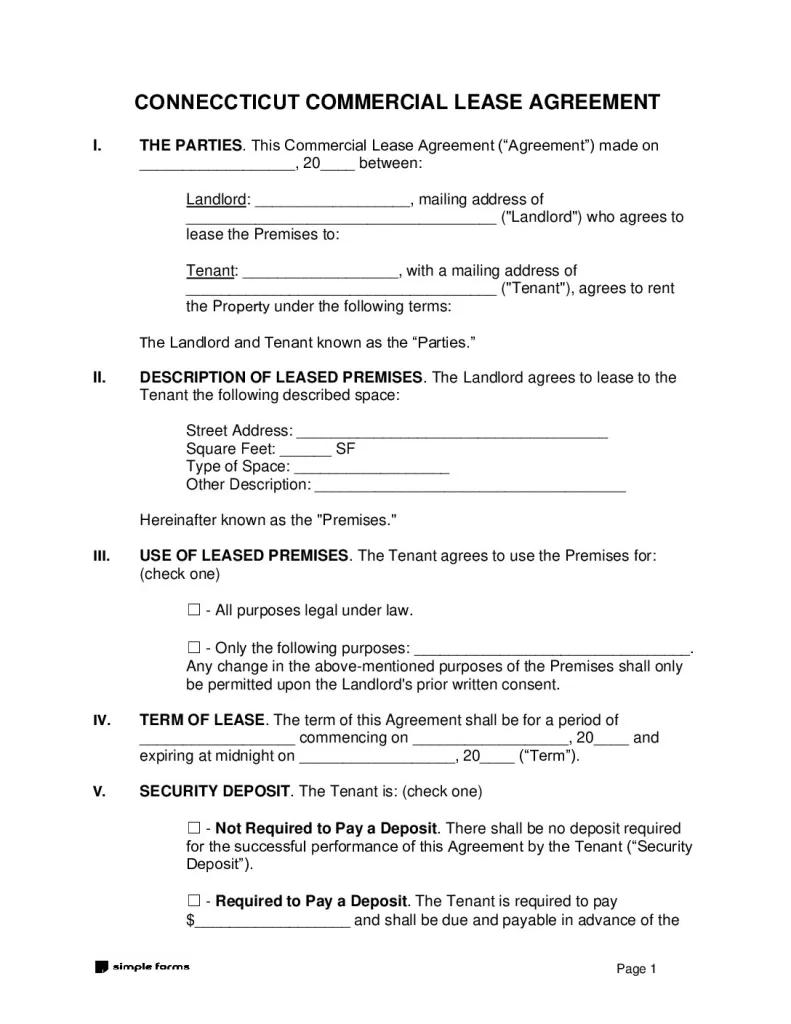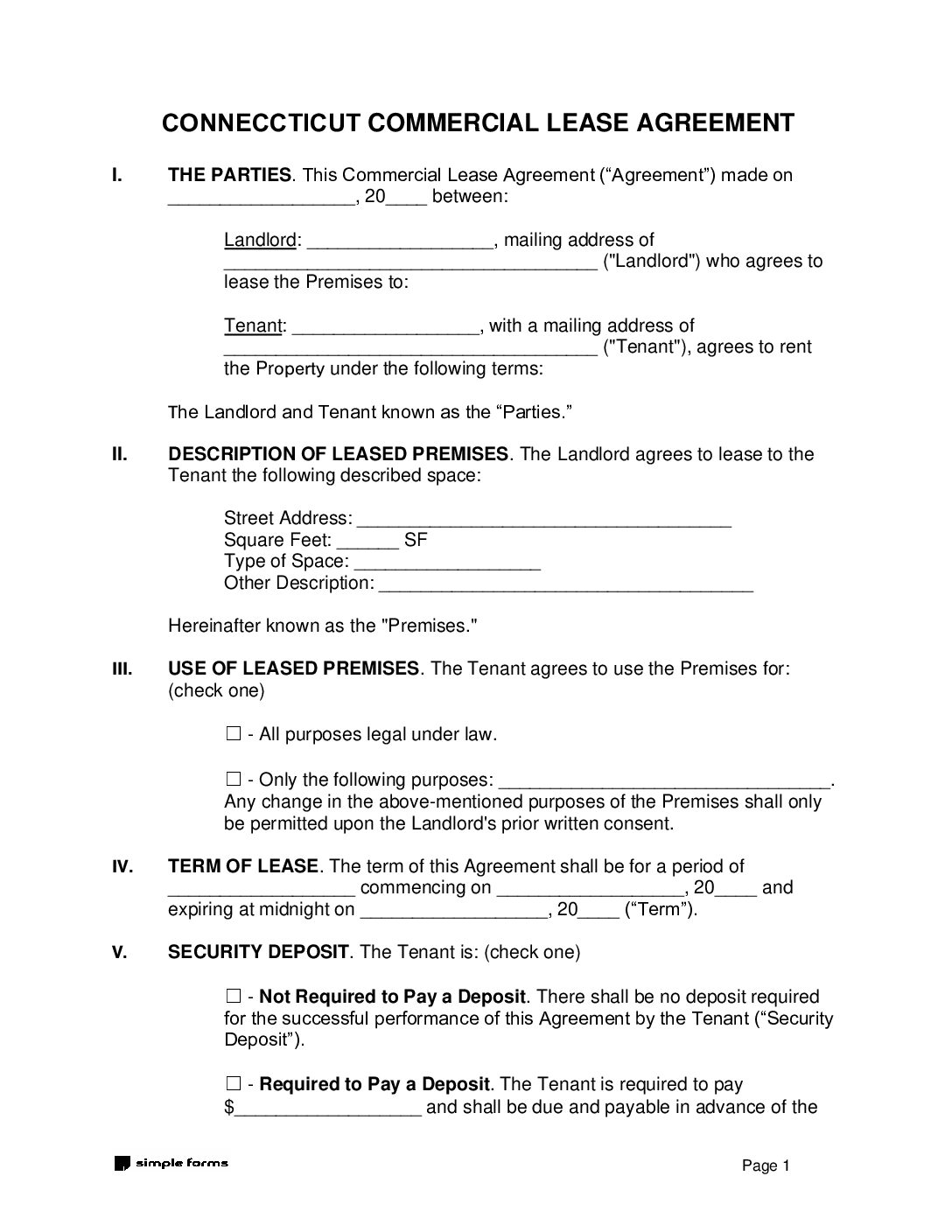The Connecticut Lease Agreement is a legal contract between a landlord or agent and a tenant. The tenant pays monthly rent in exchange for using the property for residential or commercial purposes for a set time period. The lease binds both parties until it ends.
Rental Application – offer landlords and agents an effective means of verifying the backgrounds and employment of prospective tenants. This process is essential in ensuring that tenants are well-vetted and can be trusted to abide by the terms of their lease agreements. By reviewing rental applications, landlords and agents can analyze relevant information such as credit scores, rental history, and employment records to make informed decisions about potential tenants.
Types Of Agreements
Standard Lease Agreement – A standard lease agreement is a fixed-term contract that specifies the beginning and end dates, typically for a year.
Association of Realtors Residential Lease Agreement – This is a residential lease agreement, provided by the Northern Fairfield County Association of Realtors for statewide use, that outlines the terms and conditions between a landlord and tenant. The agreement is a legally binding document that specifies the obligations and rights of both parties, and serves as a framework for the rental arrangement. It is important that all parties understand and comply with the agreement to avoid any misunderstandings or disputes.
Commercial Lease Agreement – For any non-residential property, including land, office, retail, industrial, or storage space, this is a Commercial Lease Agreement.
Month-to-Month Lease Agreement – A “tenancy at will” or month-to-month lease agreement is a type of rental contract that lacks a specified termination date and can be cancelled by either the landlord or tenant upon providing a notice to the other party. This agreement affords both parties significant flexibility, as it permits tenants to vacate the property without penalty and landlords to terminate the lease without cause, subject to certain legal requirements. Such arrangements can be useful for individuals seeking temporary housing or landlords looking to maintain flexibility in their rental arrangements.
Rent-To-Own Lease Agreement – This document presents a professional and respectful rent-to-own lease agreement template for residential properties. Our lease agreement includes the option for the tenant to purchase the premises, which allows for a more flexible and accommodating housing solution.
Room (roommate) Rental Lease Agreement – This document outlines the terms of a Roommate Agreement, which is a contractual agreement between individuals sharing a rental unit. The purpose of this agreement is to establish clear expectations and guidelines regarding payment, cleaning, and everyday responsibilities.
Sublease Agreement – A sublease agreement can be utilized to allow a subtenant to take over another individual’s lease, provided they acquire written consent from the landlord. This process ensures all parties are in agreement before any action is taken.
Disclosures (required)
Condominium Interest Community Disclosure – When vending a property situated in a communal-interest locality, it is mandatory to affix a Condominium Interest Community Disclosure (§ 47a-3e).
Landlord’s Identity (§ 47a-6) – The landlord must identify themselves in the lease and include the address where the tenant can send legal notices.
Lead-Based Paint Disclosure – In accordance with federal law, it is mandatory to provide a lead-based paint disclosure for all residential units constructed prior to 1978. Please ensure that this requirement is met to ensure compliance with Connecticut law.
Sprinkler Disclosure (§ 47a-3f) – The lease agreement must contain a disclosure statement that specifies whether a sprinkler system has been installed on the premises, along with the date of the most recent inspection. This information is crucial for ensuring the safety of the occupants and protecting the property from potential damage. Therefore, it is imperative that the landlord provides accurate and up-to-date information regarding the sprinkler system in the lease agreement.
Grace Period
Connecticut law provides a grace period of nine (9) days before the landlord can charge late fees or begin an eviction process.
Late Fees
There is no specific statute codifying the maximum penalty for belated rent payments in the United States. However, a legal precedent established in Begin v. Reissman (2005) determined that a fee amounting to 5% of the aggregate rent is deemed reasonable. The court further held that a daily late fee of $5 was excessive.
Right to Enter
It is mandated by law that the landlord is obligated to provide the tenant with reasonable notice prior to entering the property for the purpose of conducting repairs, inspections, or to showcase the property to a representative (§ 47a-16).

